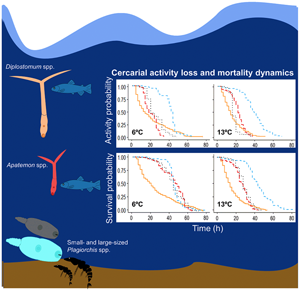Published online by Cambridge University Press: 11 November 2021

Cercarial activity and survival are crucial traits for the transmission of trematodes. Temperature is particularly important, as faster depletion of limited cercarial energy reserves occurs at high temperatures. Seasonal climate conditions in high latitude regions may be challenging to complete trematode life cycle during the 6-month ice-free period, but temperature effects on the activity and survival of freshwater cercariae have not been previously identified. After experimentally simulating natural subarctic conditions during warmer and colder months (13 and 6°C), a statistical approach identifying changes in the tendency of cercarial activity loss and mortality data was used to detect differences in three trematode genera, represented by four taxa (Diplostomum spp., Apatemon spp., small- and large-sized Plagiorchis spp.). A strong temperature-dependent response was identified in both activity loss and mortality in all taxa, with Diplostomum spp. cercariae showing the most gradual changes compared to other taxa. Furthermore, whilst activity loss and mortality dynamics could not be divided into ‘fish- vs invertebrate-infecting cercariae’ groups, the detected taxa-specific responses in relation to life-history traits indicate the swimming behaviour of cercariae and energy allocation among larvae individuals as the main drivers. Cercariae exploit the short transmission window that allows a stable continuance of trematodes’ life cycles in high-latitude freshwater ecosystems.